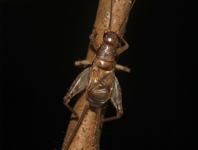Abstract
To date, half (16 of 32) of the species of Ameerega have had their tadpoles described: A. altamazonica, A. bassleri, A. bilinguis, A. braccata, A. cainarachi, A. flavopicta, A. hahneli, A. macero, A. parvula, A. petersi, A. picta, A. rubriventris, A shihuemoy. A. silverstonei, A. smaragdina, and A. trivittata (Lescure, 1976; Silverstone, 1976; Duellman, 1978; Myers & Daly, 1979; Rodriguez & Myers, 1993; Haddad & Martins, 1994; Lötters et al., 1997; Duellman, 2005; Costa et al., 2006; Twomey & Brown, 2008; Brown & Twomey, 2009; Poelman et al., 2010; Schulze et al., 2015). Ameerega boehmei is a putative member of a clade containing Ameerega braccata, A. flavopicta, A. berohoka, A. munduruku, all of which inhabit various parts of the ‘dry diagonal’ between the Amazon and Atlantic rainforests (Prado & Gibbs, 1993). Adult frogs in this group are morphologically similar, generally dark-bodied with yellow dorsolateral stripes, orange flash marks and some also possessing bright-yellow dorsal spots. Despite considerable research on their breeding behavior, acoustics and systematics (Lötters et al., 2009; Forti et al., 2013), the tadpole of Ameerega boehmei, the southern-most and western-most distributed species in this tentative group, has not been described.
References
Altig, R. & McDiarmid, R.W. (1999) Diversity: familial and generic characterizations. In: McDiarmid, R.W. & Altig, R. (Eds.), Tadpoles: The Biology of Anuran Larvae. University of Chicago Press, Chicago, pp. 295–337.
https://doi.org/10.11646/zootaxa.2049.1.1
Brown, J.L. & Twomey, E. (2009) Complicated histories: three new species of poison frogs of the genus Ameerega (Anura: Dendrobatidae) from north-central Peru. Zootaxa, 2049, 1–38.
Costa, R.C., Facure, K.G. & Giaretta, A.A. (2006) Courtship, vocalization, and tadpole description of Epipedobates flavopictus (Anura: Dendrobatidae) in southern Goiás, Brazil. Biota Neotropica, 6 (1). Available from: http://www.scielo.br/scielo.php?script=sci_arttext&pid=S1676-06032006000100006&lng=en (accessed 20 May 2019)
https://doi.org/10.1590/S1676-06032006000100006
Duellman (1978) The biology of an equatorial herpetofuna in Amazonian Ecuador. University of Kansas Museum of Natural History, Miscellaneous Publications, 1–352, 4 plates.
Duellman, W. (2005) Species Accounts: Amphibians. In: Duellman, W. (Eds.), Cusco Amazónico in The lives of amphibians and reptiles in an Amazonian forest. Comstock Publishing Association, Ithaca and London, pp. 183–305.
Forti, L.R., Mott, T. & Strüssmann, C. (2013) Breeding biology of Ameerega braccata (Steindachner, 1864)(Anura: Dendrobatidae) in the Cerrado of Brazil. Journal of Natural History, 47, 2363–2371.
https://doi.org/10.1080/00222933.2013.773099
Gosner, K.L. (1960) A simplified table for staging anuran embryos and larvae with notes on identification. Herpetologica, 16, 183–190.
Haddad, C.F.B. & Martins, M. (1994) Four species of Brazilian poison frogs related to Epipedobates pictus (Dendrobatidae): Taxonomy and natural history observations. Herpetologica, 50, 282–295.
Lescure, J. (1976) Etude de deux têtards de Phyllobates (Dendrobatidae): P. femoralis (Boulenger) et P. pictus (Bibron). Bulletin de la société Zoologique de France, 101, 299–304.
Lötters, S., Debold, P., Henle, K., Glaw, F. & Kneller, M. (1997) Ein neur pfeilgiftfrosch aus der Epipedobates pictus-gruppe vom osthang der Cordillera Azul in Perú. Herpetofauna, 19, 25–34.
Menin, M., Pinto, R.M.C., Pegorini, R.J. & Silva, M.R. da (2017) Redescription of the tadpole of Ameerega hahneli (Boulenger, 1884) (Anura: Dendrobatidae) with notes on ontogenetic variations and development habitats. South American Journal of Herpetology, 12, 236–243.
https://doi.org/10.2994/SAJH-D-17-00052.1
Myers, C.W. & Daly, J.W. (1979) A name for the poison frog of Cordillera Azul, Eastern Peru, with notes on its biology and skin toxins (Dendrobatidae). American Museum Novitates, 1–24.
Poelman, E.H., Verkade, J.C., van Wijngaarden, R.P. & Félix-Novoa, C. (2010) Descriptions of the tadpoles of two poison frogs, Ameerega parvula and Ameerega bilinguis (Anura: Dendrobatidae) from Ecuador. Journal of Herpetology, 409–417.
https://doi.org/10.1670/09-017.1
Prado, D.E. & Gibbs, P.E. (1993) Patterns of species distributions in the dry seasonal forests of South America. Annals of the Missouri Botanical Garden, 902–927.
https://doi.org/10.2307/2399937
Lötters, S., Schmitz, A., Reichle, S., Rödder, D. & Quennet, V. (2009) Another case of cryptic diversity in poison frogs (Dendrobatidae: Ameerega)—description of a new species from Bolivia. Zootaxa, 2028, 20–30.
https://doi.org/10.11646/zootaxa.2028.1.2
Rodriguez, L. & Myers, C.W. (1993) A new poison frog from Manu National Park, southeastern Peru (Dendrobatidae, Epipedobates). American Museum Novitates, 3068, 1–15.
Schulze, A., Jansen, M. & Köhler, G. (2015) Tadpole diversity of Bolivia’s lowland anuran communities: molecular identification, morphological characterisation, and ecological assignment. Zootaxa, 4016, 1–111.
https://doi.org/10.11646/zootaxa.4016.1.1
Silverstone, P.A. (1976) A revision of the poison-arrow frogs of the genus Phyllobates Bibron in Sagra (Family Dendrobatidae). Natural History Museum of Los Angeles County Science Bulletin, 1–53 + 2 color plates.
Twomey, E. & Brown, J.L. (2008) A partial revision of the Ameerega hahneli complex (Anura: Dendrobatidae) and a new cryptic species from the East-Andean versant of Central Peru. Zootaxa, 1757, 49–65.

